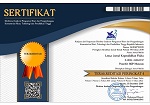MODEL PEMBELAJARAN BERBASIS MULTIMEDIA INTERAKTIF (MMI) UNTUK MENINGKATKAN PENGUASAAN KONSEP DAN KETERAMPILAN BERPIKIR KRITIS SISWA PADA MATERI OPTIK
DOI:
https://doi.org/10.33394/j-lkf.v1i2.203Keywords:
Interactive Multimedia, Concept Mastery, Critical Thinking Skills, Geometry Optics.Abstract
This study is an experimental study that aims to determine the increasing of concept mastery and the students critical thinking skills in Optical materials using Interactive Multimedia (MMI) based learning model. Optical materials in this study is limited to the Geometry Optics material. Research design using pre-test - post-test control group design. The population in this study were all students of class X SMA Negeri 2 Mataram Academic Year 2012/2013. Sampling using random cluster sampling, the students of class X-1 as the experimental group and the students of class X-3 as a control group. The increasing data of concepts mastery and critical thinking skills of students were analyzed using t-test formula two parties polled variance and N-gain test. At the significant level of 5% and dk of 79 obtained that ttest is more than ttable (5.198> 1.993). It is obtained for the experimental class N-gain of 71.338% with a high category, whereas for the control class derived N-gain of 60.261% with moderate category. Thus, it can be concluded that the increasing mastery of concepts and critical thinking skills of students in the material Optics, Optics Geometry in this case, in experiments class using the Interactive Multimedia-based learning model (MMI) is higher than in the control class that uses a conventional learning models.Â
References
Djamarah dan Zain. 2010. Strategi Belajar Mengajar. Jakarta: Asdi Mahasatya.
Fathoroni dan Gunawan. 2011. Pengembangan Media Pembelajaran Animasi Interaktif untuk Meningkatkan Hasil Belajar Siswa pada Materi Pokok Fluida Statis. Jurnal Kependidikan IKIP Mataram Vol. 10 (2) 113-124.
Gunawan. 2008. Model Pembelajaran Berbasis Multimedia Interaktif (MMI) untuk Meningkatkan Keterampilan Generik Sains Dan Berpikir Kritis Calon Guru Pada Materi Elastisitas. Tesis pada Prodi Pendidikan IPA, SPs. Universitas Pendidikan Indonesia.
_________. 2011. Model Multimedia Interaktif (MMI) Elastisitas dan Implikasinya Terhadap Penguasaan Konsep dan Keterampilan Berpikir Kritis Mahasiswa. Jurnal Kependidikan IKIP Mataram Vol. 10 (1) 29-36.
_________. 2012. Penggunaan Simulasi Interaktif untuk Meningkatkan Penguasaan Konsep Mahasiswa pada Konsep Mekanika Klasik. Jurnal Kependidikan IKIP Mataram Vol. 11(1) 25-30.
Hassoubah, Z. I. 2007. Mengasah Pikiran Kreatif dan Kritis: Disertai Ilustrasi dan Latihan. Terjemahan Bambang Suryadi. Developing Creative & Critical Thinking Skills: A Handbook for Students. 2002. Bandung: Nuansa.
Sadiman, A.S., Rahardjo, R., Haryono, A., dan Rahardjito. 2009. Media Pendidikan. Jakarta: Rajagrafindo Persada.
Sagala, S. 2010. Konsep dan Makna Pembelajaran. Bandung: Alfabeta.
Sahidu, C. 2013. Pengembangan Program Pembelajaran Fisika. Mataram: FKIP Press.
Sugiyono. 2012. Metode Penelitian Administrasi. Bandung: Alfabeta.
Warsita, B. 2008. Teknologi Pembelajaran Landasan dan Aplikasinya. Jakarta: Rineka Cipta.
Wiyono, K., Setiawan, A., Suhandi, A. 2009. Model Pembelajaran Multimedia Interaktif Relativitas Khusus Untuk Meningkatkan Keterampilan Berpikir Kritis Siswa SMA. Diakses dari http://ketangw.weebly.com/uploads/3/9/0/5/3905201/model_pembelajaran_multimedia_interaktif_relativitas_khusus_untuk_meningkatkan__keterampilan_berpikir_kritis_siswa_sma.pdf pada tanggal 03 Juni 2013 pukul 14.23.
Wiyono, K., Liliasari, Setiawan, A., Paulus, C.T. 2012. Model Multimedia Interaktif Berbasis Gaya Belajar Untuk Meningkatkan Penguasaan Konsep Pendahuluan Fisika Zat Padat. Jurnal Pendidikan Fisika Indonesia 8 (2012) 74-82.
Downloads
Published
How to Cite
Issue
Section
License
Authors who publish with Lensa: Jurnal Kependidikan Fisika agree to the following terms:
- For all articles published in Lensa: Jurnal Kependidikan Fisika, copyright is retained by the authors. Authors give permission to the publisher to announce the work with conditions. When the manuscript is accepted for publication, the authors agree to automatic transfer of the publishing right to the publisher.
- Authors retain copyright and grant the journal right of first publication with the work simultaneously licensed under a Creative Commons Attribution-ShareAlike 4.0 International License that allows others to share the work with an acknowledgment of the work's authorship and initial publication in this journal.
- Authors are able to enter into separate, additional contractual arrangements for the non-exclusive distribution of the journal's published version of the work (e.g., post it to an institutional repository or publish it in a book), with an acknowledgment of its initial publication in this journal.
- Authors are permitted and encouraged to post their work online (e.g., in institutional repositories or on their website) prior to and during the submission process, as it can lead to productive exchanges, as well as earlier and greater citation of published work (See The Effect of Open Access).

This work is licensed under a Creative Commons Attribution-ShareAlike 4.0 International License.



